Making flower shelves with your own hands: instructions for making floor, wall and corner structures
Shelves for flowers are a functional and decorative element of the room.The variety of finished products is surprising. But you can save money and make them yourself. The main thing is to choose the design you like, familiarize yourself with the method of its manufacture, then purchase the necessary materials and, strictly adhering to the sequence of operations, manufacture it.
The content of the article:
Design options
The classification of flower shelves is huge. First, let's take the installation method as a basis:
- floor;
- wall;
- hanging in the form of a swing.
By configuration:
- straight;
- corner;
- rounded;
- multi-level;
- in the form of an arch, etc.
Floor ones are divided into:
- bookcases;
- racks;
- ladder;
- A-frame design, etc.
All of the above options can also be sliding. There are modular designs, stationary or mobile, they are also mobile.
According to the material of manufacture:
- wooden;
- metal;
- plastic;
- glass;
- combined.
In the first group, not only wood, bars and boards are used, but also wooden products - plywood, OSB, chipboard, etc. The second contains a pipe, angle, fittings, wire rod and other metal profiles.
If you want to make shelves for flowers with your own hands, then choosing a model, design and material will not be difficult. This is especially true for the latter, because some materials are easy to work with, while others are more difficult. Sometimes skills in working with welding machines and electrical tools are required.
Read also - how to make a wooden floor hanger with your own hands.
Step-by-step instructions for different flower shelf options
Here you need to take into account one point - what material the shelf will be made of. Tools and fasteners will be selected accordingly. The assembly technology will also differ.
Wooden shelf for flowers “ladder”
In fact, this is an ordinary stepladder with steps that will serve as a flower stand. It’s just better to make these steps long, through the entire structure. This increases the space, which makes it possible to place more flower pots on the shelves.
First of all, you need to decide on the height of the “ladder” shelf. The higher it is, the more flower stands you can install. But there is one negative point - the higher you go, the more difficult it is to care for plants located on the upper shelves. Therefore, the optimal size is 1.5-1.8 m.
For production you will need 4 bars 30x50 mm. The length of each is 1.7 m. They need to be folded in pairs to form the letter “L”. The upper edges are overlapped. You can do everything professionally: apply markings, make precise diagonal cuts, taking into account the joining angle of two bars. But it can be simpler, because a homemade flower shelf made of wood will look good in any case.
Therefore, the upper edges of the bars, laid on top of each other, are fastened with two or three self-tapping screws. You can’t do it alone; you’ll end up with a movable joint like a hinge. The length of the screws is selected taking into account the width of the 2 bars - in our case, the length should be 60 mm. One is screwed in on one side, the other or 2 at once on the opposite side.
Two L-shaped elements are ready. Now they need to be connected to each other.To do this, you need the same bars 30x50 mm long, equal to the distance between the L-shaped posts. This option is limited by the capabilities of the location where the flower shelf will be installed. A large structure means you can install a large number of flower pots on it. But a massive shelf takes up a lot of space and is more difficult to move. The optimal size is 50 cm.
To connect the L-shaped elements, you need 2 times more crossbars than the crossbars on which the flowers will be installed. If there are 3 of them, as in the photo, then 6 crossbars are needed.
Here it is not necessary to precisely adjust them to the required parameter (join the crossbars with the racks along the internal planes of the latter). You can lay them on top of the ends, which will make it possible to trim the crossbar if it was cut incorrectly. The main thing in the entire structure is the strength and rigidity of the connection between the elements.
The photo shows 2 options for connecting crossbars to risers. The outer part of the stepladder for flowers is a connection along the internal surfaces of L-shaped elements. The second farthest one, also on the left, is the connection of the crossbars at the ends.
The next step in the instructions is preparing the shelves. They can be made from boards, plywood and other wooden elements. The width of 50 cm is the distance between the L-shaped posts. The length is selected taking into account the area protruding beyond the racks of the shelf, on which 1-2 pots of flowers can be placed.
These shelves can simply be laid on top of the crossbars, but it is better to secure them with self-tapping screws - 2 on each side is enough. Sometimes you need to lift the outermost pot in order, for example, to replace it with another. In this case, a flower that stands on the opposite edge can create a load. Under its action, the principle of the rocker will play, causing the shelf to turn over.
Cross members can be installed not between the L-shaped elements, but inside them. The letter “A” will be formed with several crossbars. The shelves placed on them must be secured with self-tapping screws so that the product does not fall apart.
The distance between the shelves is determined by the height of the flowers that will be installed on them.
Shelves for flowers in the form of a ladder are a huge variety of designs. For example, a classic stepladder, in which one part is a ladder with steps, the other is a support that supports the first one from falling backwards. Flower pots will be placed on the steps.
Another model is the classic staircase. Only her steps are not ordinary plank beams mounted on edge, but boards or pieces of cut plywood laid almost in a horizontal plane. The angle of inclination is equal to the angle at which the ladder will be applied to the wall.
It is easier to make than previous models. Two long slats are fastened together by crossbars, they are also steps in the classic version. They are equipped with shelves cut from plywood, OSB or chipboard, which are attached to both the steps and the racks. In this case, a slope is formed so that the shelves, after installing the ladder, are in a horizontal plane.
In order for a wooden flower shelf to have a presentable appearance and last a long time, all elements of its design need to be treated:
- All surfaces are cleaned with fine sandpaper.
- Treatment is carried out with an antiseptic composition. It will protect against mold, which may appear when water spills on a wooden shelf while watering flowers.
- The entire product is coated with paint or varnish. The latter is widely represented on the market - it is not only colorless.There are multi-colored varnishes that will help you fit the ladder into the interior of the room.
This flower shelf can be made mobile. To do this, you need to attach furniture wheels to the racks of the L-shaped elements.
There is another interesting option, which can be called not a ladder, but a staircase. Its shape is exactly like a ladder, which is used to move from floor to floor. Structurally, these are 2 side supporting bases on which the steps are laid. There are some difficulties in construction here. Therefore, to make it yourself, it is better to take a different design as a basis. It is clearly visible in the picture below.
Essentially, these are 4 benches pulled and placed next to each other. It is necessary to make these same benches of different heights. The shelf option is also interesting because the installation sequence of the benches can be changed at your discretion, or moved separately, which is also a big plus.
Preparation method:
- From a block with a cross section of 50x50 mm, 4 racks of the same length are cut out.
- They are tied with bars of the same cross-section around the perimeter (2 long slats and 2 short ones are used).
- A flooring of 25x50 mm bars, 20-25 mm thick boards or 12-16 mm thick plywood is laid on top.
- Fastening - self-tapping screws. You can use bolts and nuts.
Corner wooden shelf for flowers
This type of flower shelves is considered an economical option. It can be used to fill in areas that are rarely used.
Essentially, this is a bookcase that fits in the corner of the room. The height and width of the shelf can be chosen at your discretion. The picture clearly shows the design of the device. These are 3 racks, between which shelves for pots of flowers are distributed along the height.The latter can be square or rectangular (the lowest) or with a rounded outer corner (all the others).
What you will need:
- 3 slats with a cross section of 50x50 mm.
- The material for the shelves is any flat wooden product: plywood, OSB or laminated chipboard. You can use wide boards.
Here it is important to decide on the method of fastening. The best option is to use metal perforated corners. To do this, you need to make seats for them in the racks, because the junction of the stand with the rack runs along the corner (edge) of the latter. Therefore, the height of the metal corner shelf is measured.
The size is transferred to the rack, where a cutout (recess) is made for the fastening element. The important thing here is to ensure that the mounting holes fit into the rack to which the shelf will be attached.
In this way, the entire structure is assembled, starting from the outer crossbar under the flowers to the opposite one. There is another option - 3 racks are connected to each other by crossbars made of bars of a smaller cross-section, for example, 30x30 mm. They are mounted inside the structure so that the shelves themselves can be laid on them. In this case, the latter are not attached to the racks. This option can be floor or wall mounted.
Corner shelves for flowers are also a huge variety of designs. Here you can use the same benches, placing them along adjacent walls. Or assemble a single non-separable bookcase, where the levels are located on different sides at different heights.
Despite the apparent simplicity of the flower shelf in the photo, it is actually not so simple. But you can do it yourself. The main thing is to choose the right dimensions and clearly think through the assembly sequence.
Wall shelf for flowers "vine"
This version of the flower shelf is the most complex.It is made of metal. Twisted and curved elements require special equipment and devices during manufacture. All elements are connected to each other by electric welding, which requires a welding machine, tools for it, and the ability to handle it.
If you don’t have any tools, equipment, or the ability to work with them, then you won’t be able to make a flower shelf in the shape of a vine with your own hands. Today, construction stores have almost everything related to construction and interior design. Elements of the “grapevine” are present in the stores. You can buy them and try to combine them into a single structure with your own hands. But for this you still need a welding machine and consumables for it.
If you want to make such a shelf for flowers, then you need to decide on its shape and size. Next, make a sketch on paper to understand whether it turned out as planned. Usually, attention should be paid to the bends of the vine, the number and location of grapes, and leaves. The same goes for flower pots.
You can make rings for flowers or buy large metal grape petals in the form of separate shelves. It is imperative to take into account the number of fastening elements and the places where they will be welded. And after that you can purchase elements of the “grapevine” shelf.
Now the assembly process, which must be carried out strictly according to the sketch, because all parts of the shelf were purchased to the required dimensions. Deviations are possible, but small:
- Electric welding is used to connect parts of the vine or several of them. Do spot welding. After alignment, the joints are welded using a continuous seam. Scales and deposits are knocked off with a hammer.
- Petals, bunches of grapes and other decorative elements are welded to the vines: insects, flowers, etc.
- Fasteners are welded. Usually these are steel lugs. 2-3 is enough. It is important here that they are durable and can withstand a sufficiently large weight of the shelf for flowers and flower pots.
- Painting the structure.
A few words about painting. To do this, you can use paints in spray cans. They are inexpensive and require minimal consumption. So several pieces with different colors will be enough for more than one shelf.
Before applying paint, the structure must be treated with a solvent or degreaser and cleaned of dirt.
There are no restrictions in terms of paint application. The color scheme is at the discretion of the owner of the house. Someone wants to exactly repeat the design of the shelf, like natural grapes. Someone treats this moment abstractly, using completely extraordinary solutions.
Forged metal shelves for flowers
The manufacturing process is the same as in the previous paragraph. All elements, forged and not forged, are connected to each other by electric welding. Forging can be done using cold forging technology, for which a bending machine is used. It must be borne in mind that not all types of metal profiles are used to create shelves for flowers.
The following are mainly used:
- Thick wire, also known as wire rod, with a diameter of 6-8 mm. Usually it is used to make wall forms, which are light and elegant. In addition, the wire is easy to work with. It can also be used in structures made of other metal profiles or other materials.
- Round bars, also known as smooth reinforcement.
- Square bars. They are mainly used to make supports and racks, although, as can be seen in the photo below, they make original shelves for flowers.
- Decorative elements made of sheet metal: leaves, insects, balls, bows, etc.
The picture shows the original shaped shelf. But at the same time, it is simple and does not require complex manufacturing. Essentially, these are 2 pairs of different elements that differ from each other in shape. The shapes are mostly rounded, which simplifies the process of forging them. Square bars must be passed through the rolls of a bending machine, precisely adhering to the dimensions and configuration of the bends. Since these are 2 pairs of base, they can be bent in pairs, which speeds up and simplifies the manufacturing process.
You can learn how to cold forge. But you shouldn’t waste time on training if the flower shelf is made in a single version and is disposable. It is better to order the production of elements in a workshop. You can also purchase material there. The main thing is to provide the master with a drawing or sketch of the future shelf.
Here in the workshop you can cut cross members from the same square rod, which will need to be used to connect the structural elements together. But you can do the cutting yourself, using a grinder and a diamond cutting wheel.
If all parts of the shelf are ready, you can proceed to assembly:
- Connect 2 parts of the heart on the floor or workbench (on a flat surface). Spot welding is carried out. The same with another similar part.
- The lower part – rounded legs – is welded to each of them. It can be connected from inside the structure or from the outside.
- We ended up with 2 identical parts that now need to be combined into one structure. Cross members are used for this.
- One part of the shelf is placed on the table. All connecting rods are vertically welded to it. A construction corner is used to set the vertical.
- The second part is placed on the table. The inverted first part with welded cross members is installed on it so that the latter free ends rest against the second part lying on the table.
- Both parts are aligned relative to each other so that one is not lower or higher than the other. Or one part protruded beyond the other.
- The rods are welded to the second element of the flower shelf.
Here you need to first designate the installation locations for the transverse rods, some of which will become supports for the shelves where the flower pots will be installed.
The finished product needs to be finalized:
- the welding areas are cleaned of deposits, scales and drops of metal;
- if some joint seems unreliable in terms of strength, then it is better to finish welding it now;
- all shelves are treated with a solvent, cleaned and degreased;
- paint is applied.
All that remains is to install the finished shelf at its destination. Place flower stands. And put the latter on them.
Simple flower shelf designs
There are a huge number of simple flower shelf designs made from materials that you probably have in your home. For example, a shelf made of organic glass or a stand made of plywood.
To do this, you need 2 fastening elements in the form of corners that are attached to the wall. You can make them yourself from steel tape 2-3 mm thick and 30 mm wide.
For example, you need a ribbon 20 cm long, which must be bent in half at a right angle. On 2 shelves of the resulting corner, 2 through holes are made.
A flower stand is being prepared. In the photo below it is made of plexiglass. But you can use any flat material: plywood, boards, sheet iron, plastic panels, etc.
Now we need to install the corners, they are now brackets, on the wall. Mounting method: self-tapping screws:
- Install one bracket and make marks with a pencil through the holes.
- Set it aside.
- Make holes according to the marks, into which plastic dowels are immediately driven.
- The corner is installed in place and secured to the wall with self-tapping screws.
- The second bracket is installed on the wall at the location where it is attached.
- Place a flower stand on both corners and use a building level to level the shelf horizontally.
- The stand moves to the side.
- Marks are made on the walls through the holes of the second bracket - it is attached to it in exactly the same way as the first.
- The stand for the pots is laid on top of the mounting corners and attached to them with self-tapping screws or bolts.
You can do the same thing using another method. First assemble the shelf, then install it at the installation site, level it horizontally. Then make marks in two brackets on the wall at once, drill holes, insert dowels and attach the structure to the wall with self-tapping screws.
Metal holders can be replaced with wooden ones made from slats. There are ready-made plastic brackets available for sale. The essence of the design remains unchanged - simple, concise and functional.
There is a very simple design of a flower shelf designed for one pot. By hanging several of these shelves along the entire wall or along the walls, you can solve the issue of completely dispersing vegetation throughout the room.
For example, like the one in the photo below. Essentially, this is a board from which a semicircle has been cut. You can use a log cut crosswise, the pancake of which is sawn to the diameter.Here it is important to decide whether to leave the shelf in its original form, without modification, or modify it to the furniture look shown in the picture.
The manufacturing process itself involves almost one operation, not counting cutting out the semicircle. You need to make 2 holes at the end of the wooden pancake for pins, onto which the flower stand will be mounted. This is best done on a drill press using a feather drill. The diameter of the hole is slightly larger than the diameter of the pin. The last parameter is usually 8-12 mm.
The distance between the holes is transferred to the plane of the wall. The marks should be located on a horizontal line. Holes are made in them into which a dowel is driven under a pin (plastic or metal), and the dowel itself is immediately screwed into it. This is how 2 pins are installed, onto which a wooden flower stand is placed.
The variety of shelves for flowers is huge - it’s not difficult to choose something for your home or apartment. You can make some designs with your own hands, taking into account your skills in working with tools and the availability of these tools.
But not all shelves can be made independently. This especially applies to those where manufacturing requires machines or complex equipment. But there are simple models; making them is not difficult.
Someone has already made flower shelves with their own hands - please respond. We are all interested in your experience. What materials were used? Which form did you choose? Was it a wall model or a floor model? Or did you choose the window sill? Write in the comments.
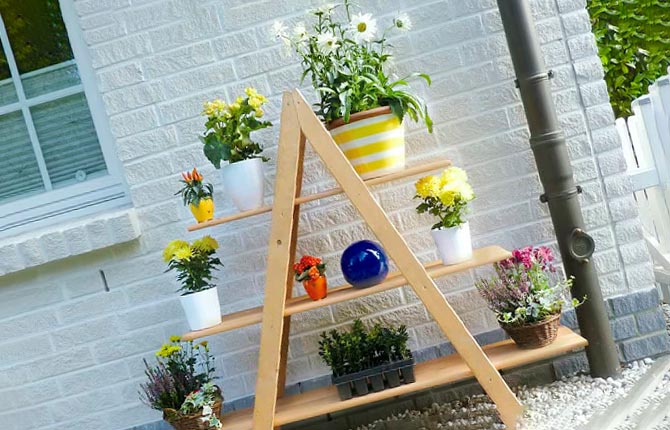
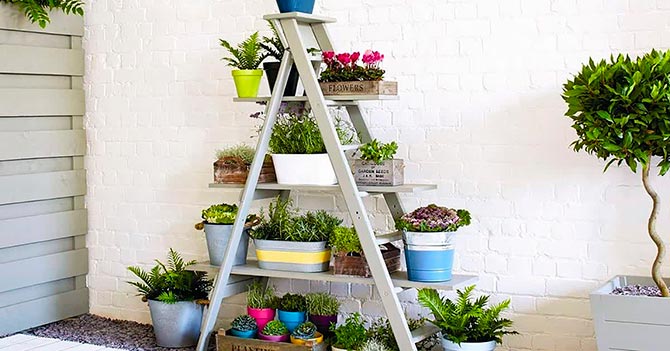
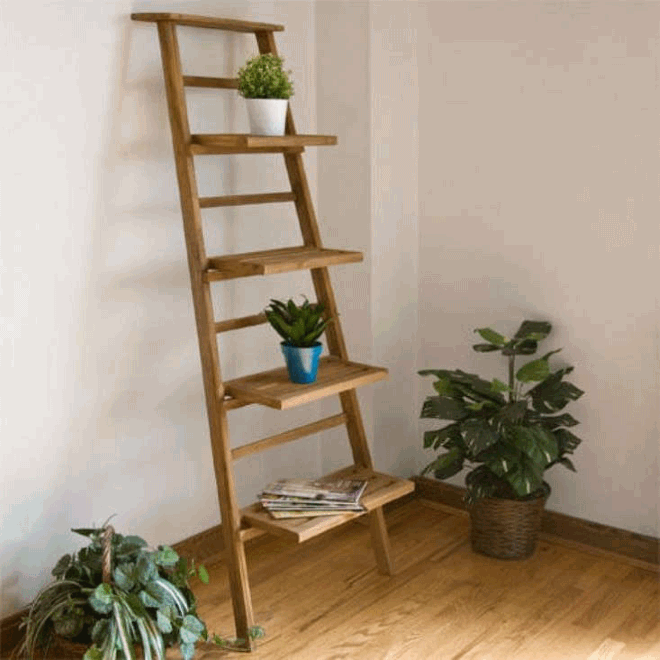
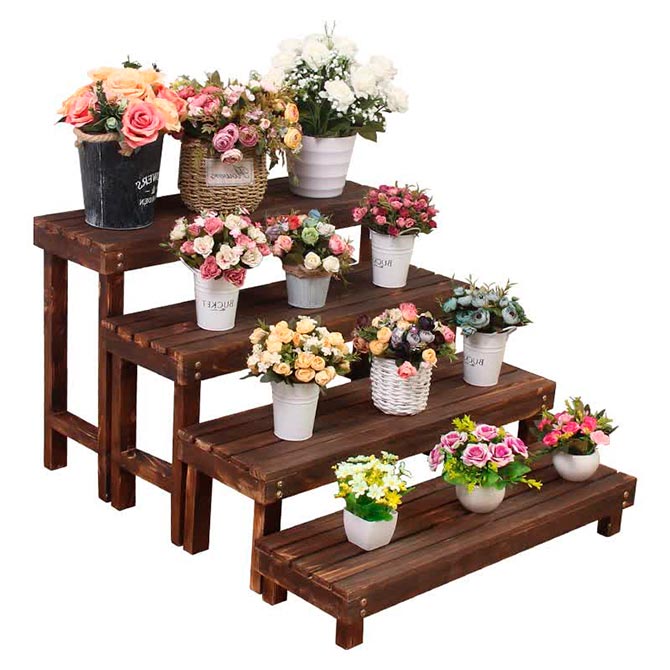
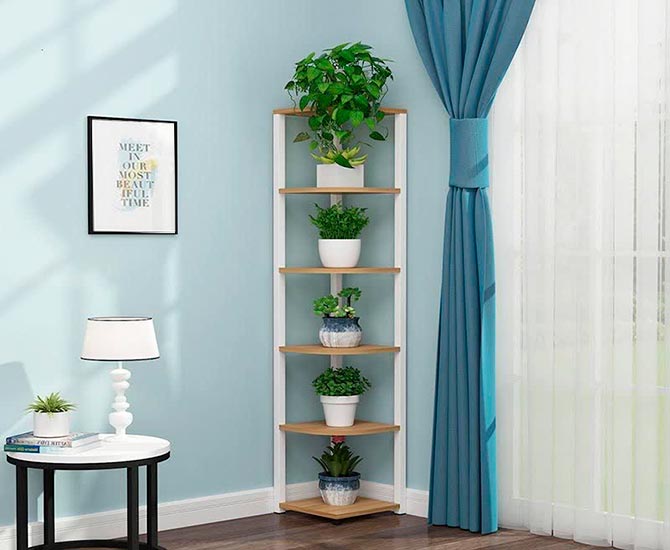
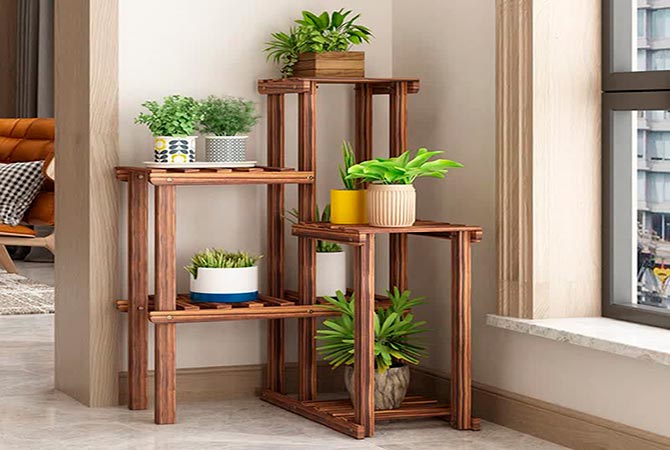
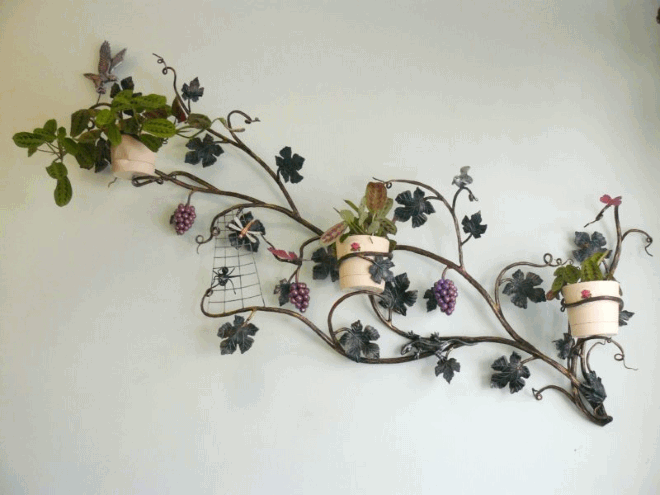
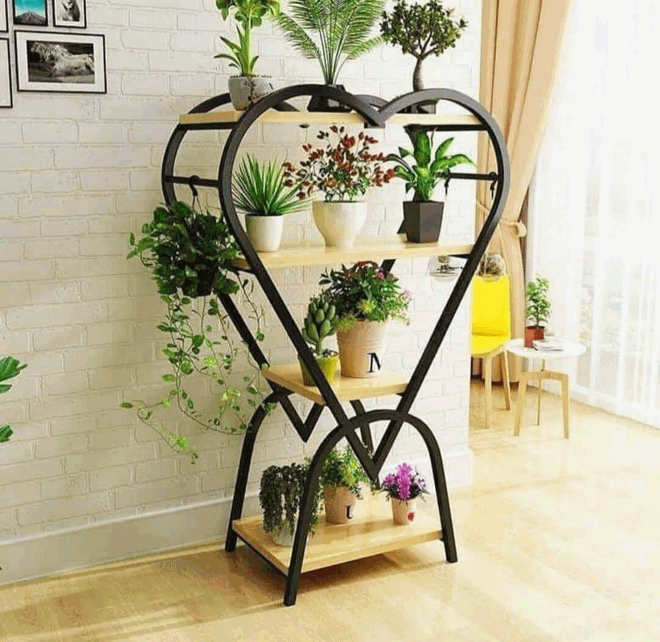
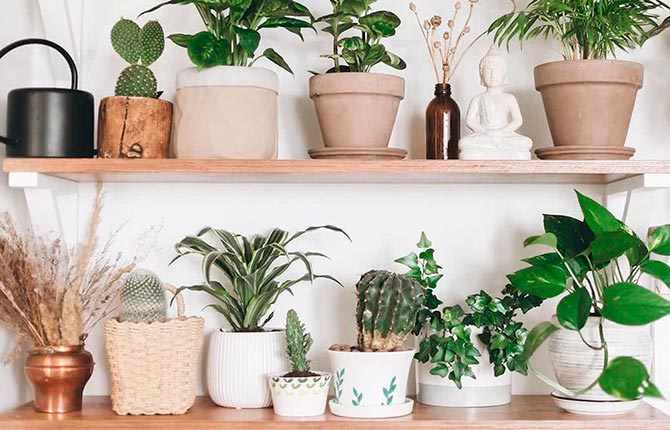
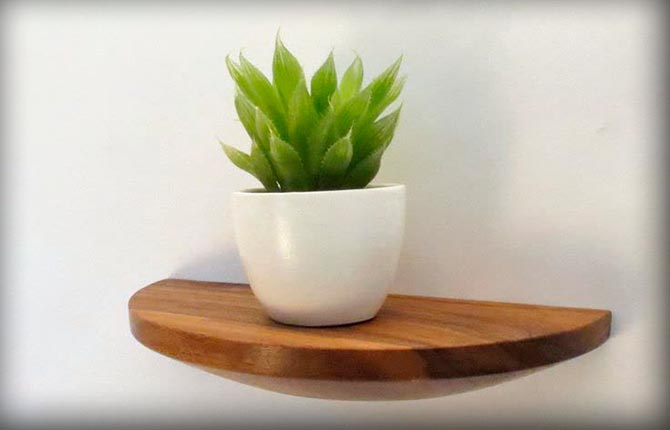




I did exactly the same as you described in the article. I bought two steel brackets in a store. I installed them on the wall and placed regular window glass 4 mm thick on top.They turned out to be elegant shelves.
I made shelves from plywood, there were a few sheets left after repairs. The shape is a bookshelf with an open top. I connected the stand to the sides with metal corners and bolts. Metal ears were used as fasteners to the wall; I attached them to the sides of the structure. I coated the shelf with clear varnish. The edging with an aluminum profile turned out very well.